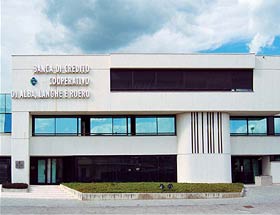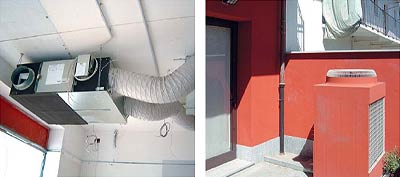A well planned investment
 The banking sector has some special features when evaluating the technical systems and, in particular, air conditioning systems, due to the widespread view of each component as the subject of investment and therefore analysed with a sensitive approach to issues such as return on investment, operating costs and useful life expectancy.
The banking sector has some special features when evaluating the technical systems and, in particular, air conditioning systems, due to the widespread view of each component as the subject of investment and therefore analysed with a sensitive approach to issues such as return on investment, operating costs and useful life expectancy.
It is understandable that each banking institution is prone to analysing every aspect of its investment, and air conditioning systems are no exception to this rule, although these assessments are joined by requirements of a purely technical nature, such as the availability of qualified and reliable technical support, reliability of products and systems, possibility to modify and implement the systems in view of changes in use during the operational life of the building, and so on.
In recent years, in addition to all this, banks have paid special attention and are more sensitive to issues such as sustainability, environmental protection and use of green energy from renewable sources. The banking sector is hence proving itself to be one of the most demanding sectors in the choice of products and equipment, as the administrative and procurement managers are necessarily used to considering all investments under the double aspect of their financial value and their ability to perform the tasks assigned to them.
A significant example of this occurred in the case of the Banca di Credito Cooperativo di Alba Langhe e Roero, when management was faced with choosing the air conditioning system for the new branch in Vezza d'Alba, a modern building made from reinforced concrete with large windows. During the meetings between the management of the Bank and Mitsubishi Electric directors, the need to provide appropriate climate control systems for the main branches of the area also emerged.
This need prompted Mitsubishi Electric to develop a comprehensive approach that focused on the features below:
- a remote management system installed at the individual branches and controlled by the bank headquarters or by Mitsubishi Electric itself;
- choice of components and systems for branches with the dual purpose of supplying standardised products and components in order to limit the initial cost and the number of spare parts to be kept in stock;
- choice of high energy efficiency VRF air conditioning systems to reduce energy consumptions and therefore system operating costs.
All this has repeatedly occurred, and the management of the Cooperative Credit Bank of Alba, Langhe and Roero he could get a full satisfaction for both the financial aspects related to investment, both for all the properties expressed by technological and operational systems.
The plus points of VRF heat recovery systems
Most of the systems installed at the Vezza d'Alba headquarters and the area branches use VRF heat recovery systems produced by Mitsubishi Electric. These systems provide some of the highest energy efficiency levels in the industry and are reputed to be "state of the art" systems due to their technological content and operational functionality. Some of the key features include:
- Capacity to provide simultaneous cooling and heating by exploiting the diversity of loads in the relative areas. - In other words, the VRF heat recovery systems work by transferring excess heat, for example from the areas in direct sunlight, to the colder areas which need more heat as they are in the shade. - All this is achieved with a minimum use of energy from the outside as the system does not "produce" cooling energy or thermal energy, but transfers the thermal energy from the areas where it is abundant to areas where it is insufficient. - This means that power consumption is minimal, resulting in very low running expenses.
- Extensive control and management potential; the Melans system, which stands for Mitsubishi Electric Air Conditioning System Network, is an advanced digital remote control management system with a user-friendly interface characterised by easy navigation icons. - It is able to provide users with information on the main operating system settings, such as controlled variables, operational modes and fault or malfunction reports. - This type of remote control systems perform numerous main functions listed as follows:
- Control of a wide range of temperatures, in Cool/Dry, Heat and Auto modes (built-in sensor)
- Adjustment of fan speed on the indoor unit - Display of error codes and unit malfunctions
- Adjustment of airflow streams for relative units
- Selecting of operating mode
- Timer programming.
- The system uses a simple non polarized two-wire cable, directly connected to the indoor, outdoor and remote control units foreseen in the local control architecture. - The development of a suitable interface that looks like a normal website means that the VRF machines can be controlled and managed via the Internet, with the economic advantages of being able to monitor the system at any time and from any location.
- Non-invasive systems, a specific feature of VRF direct expansion systems compared to hydronic versions. This led the Bank to choose these systems for its new headquarters and especially in the various branches which are located in existing buildings that often have problems of availability of space. - The compact features of the indoor units, the choice between vertical or horizontal models, with direct or ducted air flow systems, the small diameters of the refrigerant lines and outdoor units in modules made this the perfect solution for all the locations.
Air-conditioning solutions
Given the extensive flexibility provided by VRF heat recovery systems, it was possible to create and install engineering solutions that met all the specific requirements of the headquarters and various branches, where Lossnay heat recovery systems were also installed to handle outdoor air ventilation, recovering heating or cooling energy, depending on the operating mode, from the exhausted air. According to the environmental requirements ducted indoor units were installed to provide uniform air distribution in all the relative zones.
The cooling capacities most commonly used at the branches ranged from between 20 to 45 kWf, the number of indoor units was between 4 and 13 according to the zone types. The management and control system used on all air conditioning systems provide the following range of functions:
- Control of a wide range of temperatures, in Cool/Dry, Heat and Auto modes (built-in sensor)
- Indoor unit fan speed adjustment
- Display of error codes and faulty units;
- Adjustment of airflow streams for units with this feature;
- Selecting of operating modes;
- Timer programming
Some functions, such as time programming, stopping and starting the system, setting of vacation periods, alarm and other similar warnings are centralised via the remote control panel. Adjustment and control of the headquarters systems is performed via personal computers by the controller manager.
Assessment of return on investment
Estimates and computer models were used to evaluate the use of VRF heat recovery systems in the type of buildings described, can lead to reductions of up to 33% in energy consumptions compared to conventional hydronic systems, at the same rate of installed power. As the cost of purchasing a VRF heat recovery system is the same in order of magnitude as that of a 4-pipe primary air fan coil system, we estimated that, as far as energy consumption savings are concerned, the VRF system pays for itself completely in just 4 years. In addition to the above, an aspect that should not be underestimated is the benefit of having just one warranty for the VRF systems and therefore relative the relations with one supplier - Mitsubishi Electric - unlike those cases using traditional hydronic systems, made of components and equipment produced by several different manufacturers. This greatly reduces administrative operations, maintenance management and, ultimately, hidden costs that often add up to quite considerable amounts.
A powerful monitoring platform
The G-50 centralised controller is the core application of the Melans technology and a web server capable of containing the 10-Mbps Ethernet port and relative embedded software. It can handle up to 50 air conditioning and air handling units, in either individual or collective mode exploiting the proprietary network M-Net and, via the Ethernet network, interfacing with any PC and BMS system
via the standard TCP/IP or XML communication protocol.
The software embedded in the controller reflects what is normally viewed when accessing a website: The actual operating conditions of the indoor units are displayed on the user's monitor using an icon format through which operators gain direct access to the virtual machine control panel.
This graphic interface enables the performance of all main machine data read and control operations quickly and easily, with the option of accessing complex functions such as energy optimisation and cost allocation.
The large sized systems, such as those installed a the headquarters of the Banca di Credito Cooperativo di Alba Langhe e Roero do, however, require a more complex approach, which can result in a supervisory platform that integrates the concepts of interoperability and scalability, in addition to maximum conformity with all Building Automation, Controls and Building Management (TC247) European Standards, through the implementation of standard protocols.
The solution developed by Mitsubishi Electric, which is able to effectively control up to 2,000 air conditioners, is to centralise the facilities by means of a new management system, called TG-2000, which represents the highest level of the entire Melans architecture.

Una fase di installazione di un recuperatore di calore Lossnay in una delle filiali della Banca.
Installazione di una unità esterna del sistema VRF in una delle filiali.
An installation phase of a Lossnay heat recovery system at one of the Bank’s branches.
Installing an outdoor unit of the VRF system at one of the branches.
It consists of a centralised multi-station equipped with a multi-tasking operating system with enhanced graphics which is able to supervise large or small system layouts using its scalability function, even by geographic area using the cutting edge "wide area" module.
The simple and user-friendly graphic interface guides the user in navigating through the entire system installed in the building, using interactive icons, to locate all the installed air conditioning units are the various third party technological equipment connected to the PLC or the intelligent terminals on the indoor units.
Selecting an icon triggers the display of the air-conditioner unit’s virtual control panel: To simplify matters, the machines can be selected according to predefined groups and zones, and through this function, a command is simultaneously transmitted to multiple utilities.
The versatility of the TG-2000 software allows the use of both standard and special functions. The standard functions provide comprehensive management and control of air conditioners as follows:
- adjustments to air-conditioning via the virtual control panel
- Daily, weekly and annual timer programming
- The registration of operational data such as alarms, hour counters etc...
- Graphs illustrating trends of variables and consumption, with export data functions
- The collective management of multiple air conditioners.
If the standard functions provide complete operational management of the system, the optional functions ensure energy control by means of:
- The monitoring and distribution of consumptions (Charge), in table and graph formats
- Dynamic control of power consumption (Energy saving/Peak cut).
This ensures the system Operator is informed in detail on the building's energy profile and, upon analysing the data made available by the system, can implement energy saving and low consumption strategies.
Machinery and equipment
In the case of the Banca di Credito Cooperativo di Alba Langhe e Roero headquarters and branches, PUHY P250YGMA, PUHY-P400YGMA outdoor units were installed
PURYP250YMF-C-PURY P200YMFC.
Download
Case History
Download the complete Case History
Download

